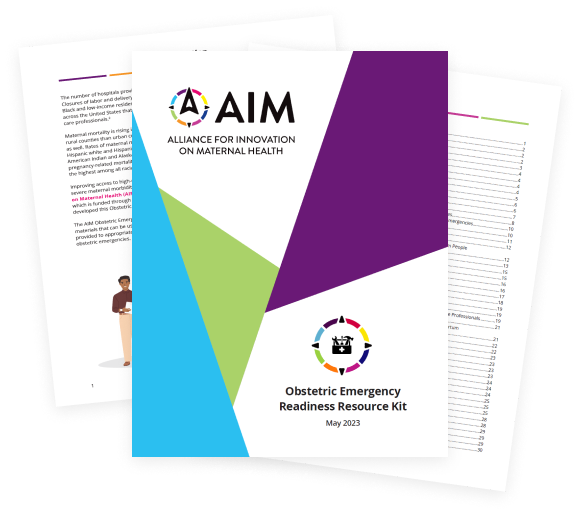
The AIM Obstetric Emergency Readiness Resource Kit is a collection of best practices to aid in readiness efforts to appropriately care for patients experiencing obstetric emergencies in non-obstetric or lower-resources settings. This resource kit may particularly benefit those who do not typically provide obstetric services or encounter obstetric emergencies
Resource Kit Scope and Highlights
- This resource kit is not intended to be a response manual but rather provides background and resources for review, planning, prioritization, and adaptation to unique needs and clinical settings to support readiness efforts in advance of an obstetric emergency.
- This resource kit may particularly benefit Family Medicine and Emergency Medicine clinicians, nursing administrators, and other leaders in clinical settings that may not routinely encounter an obstetric emergency.
DOWNLOAD BY SECTION OR TOPIC
Individual sections of AIM’s Obstetric Emergency Readiness Resource Kit are available for download below.

Table of Contents
- An overview of contents of the resource kit

Introduction & Resource Kit Keys
- The background and purpose of the resource kit
- How to interpret and use resource kit content

Readiness
- Building rapid response teams
- Example policies, procedures, protocols, and checklists
- Drills, simulations, and trainings

Recognition & Prevention
Section highlights:
- Pregnancy screening
- Triage of pregnant and postpartum patients
- Screening for other risk factors and comorbid conditions

Response – General
- Routine births in non-obstetric settings
- Perimortem Cesarean delivery

Response – Obstetric Hemorrhage
- Critical signs and symptoms
- Response and clinical keys
- Practice resources

Response – Perinatal Mental Health Conditions
- Screening
- Response and clinical keys
- Practice resources

Response – Severe Hypertension in Pregnancy
- Critical signs and symptoms
- Response and clinical keys
- Practice resources

Response – Sepsis in Obstetric Care
- Critical signs and symptoms
- Response and clinical keys
- Practice resources

Response – Care for Pregnant & Postpartum Patients with Substance Use Disorder
- Screening
- Response and clinical keys
- Practice resources

Response – Cardiac Conditions in Obstetric Care
- Critical signs and symptoms
- Response and clinical keys
- Practice resources

Reporting & Systems Learning
- Huddles, debriefs, and action planning
- Multidisciplinary reviews of obstetric care and emergencies

Respectful, Supportive, & Patient-Centered Care
- Communications and shared decision-making strategies
- Provider and staff education and training
DOWNLOAD BY SECTION OR TOPIC
Individual sections of AIM’s Obstetric Emergency Readiness Resource Kit are available for download below.

Table of Contents
- An overview of contents of the resource kit

Introduction & Resource Kit Keys
- The background and purpose of the resource kit
- How to interpret and use resource kit content

Readiness
- Building rapid response teams
- Example policies, procedures, protocols, and checklists
- Drills, simulations, and trainings

Recognition & Prevention
Section highlights:
- Pregnancy screening
- Triage of pregnant and postpartum patients
- Screening for other risk factors and comorbid conditions

Response – General
- Routine births in non-obstetric settings
- Perimortem Cesarean delivery

Response – Obstetric Hemorrhage
- Critical signs and symptoms
- Response and clinical keys
- Practice resources

Response – Perinatal Mental Health Conditions
- Screening
- Response and clinical keys
- Practice resources

Response – Severe Hypertension in Pregnancy
- Critical signs and symptoms
- Response and clinical keys
- Practice resources

Response – Sepsis in Obstetric Care
- Critical signs and symptoms
- Response and clinical keys
- Practice resources

Response – Care for Pregnant & Postpartum Patients with Substance Use Disorder
- Screening
- Response and clinical keys
- Practice resources

Response – Cardiac Conditions in Obstetric Care
- Critical signs and symptoms
- Response and clinical keys
- Practice resources

Reporting & Systems Learning
- Huddles, debriefs, and action planning
- Multidisciplinary reviews of obstetric care and emergencies

Respectful, Supportive, & Patient-Centered Care
- Communications and shared decision-making strategies
- Provider and staff education and training
APPENDICES & OTHER RESOURCES
Appendix A
- Condition- and event-specific equipment and medications for care of obstetric patients in the Emergency Department

Appendix B
- Example supplies list for an obstetric hemorrhage cart, bag, or box

Maternal Hemorrhage Flow Sheet
- Example obstetric hemorrhage documentation flowsheet for inclusion in a hemorrhage cart, bag, or box

Printable Facility Example Hemorrhage Cart Supply List
- Printable facility example hemorrhage cart supply list
Identifying and Managing Obstetric Emergencies in Nonobstetric Settings

Cardiovascular Disease (CVD) in Pregnancy & Postpartum Algorithm
Section highlights:
- Cardiac Disease in Pregnancy and Postpartum Algorithm for Care in Emergency Departments

Acute Hypertension in Pregnancy & Postpartum Algorithm
Obstetric Simulation Scenarios for the Emergency Department
- Six scenarios
- Can be used in any level of fidelity simulation
Obstetric Emergency Readiness Measurement Strategy
- Measures to support data-driven quality improvement in non-obstetric settings.
Obstetric Care Assessment for Resource-Limited Environments (O-CARE)
Section highlights:
- Tools to assist health care teams in evaluating system readiness and care provided in resource limited settings.
APPENDICES & OTHER RESOURCES
Appendix A
- Condition- and event-specific equipment and medications for care of obstetric patients in the Emergency Department

Appendix B
- Example supplies list for an obstetric hemorrhage cart, bag, or box

Maternal Hemorrhage Flow Sheet
- Example obstetric hemorrhage documentation flowsheet for inclusion in a hemorrhage cart, bag, or box

Printable Facility Example Hemorrhage Cart Supply List
- Printable facility example hemorrhage cart supply list
Identifying and Managing Obstetric Emergencies in Nonobstetric Settings

Cardiovascular Disease (CVD) in Pregnancy & Postpartum Algorithm

Acute Hypertension in Pregnancy & Postpartum Algorithm

Obstetric Simulation Scenarios for the Emergency Department
- Six scenarios
- Can be used in any level of fidelity simulation

Obstetric Emergency Readiness Measurement Strategy
Section highlights:
Measures to support data-driven quality improvement in non-obstetric settings.

Obstetric Care Assessment for Resource-Limited Environments (O-CARE)
Section highlights:
Tools to assist health care teams in evaluating system readiness and care provided in resource limited settings.












